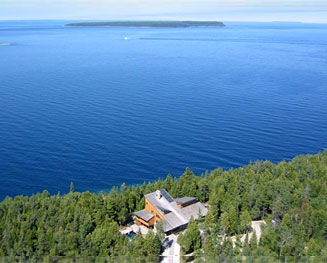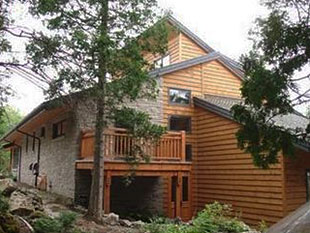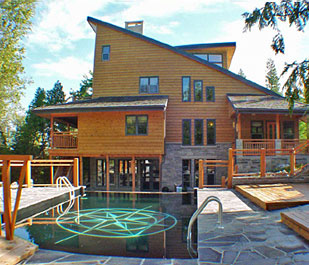When Laurie Adams, a fourth generation resident of the Bruce Peninsula, Ontario, expressed her vision for a luxury inn that would have only a minimal impact on the environment, she was told it was impossible. Fueled by her passion for and commitment to the environment, she took on the challenge. After five years of considering every aspect, material choice and impact, the E'Terra Inn has emerged as a stunning example of what is possible in the Green Building realm.
The Building
Overview
Completed in 2005, this six-room luxury inn is perched on the banks of Georgina Bay north of Toronto, Canada. The most important feature of the building is the consideration behind each and every element used to erect it. The resulting building complements its natural environment and minimizes its impact on the environment in a variety of ways. Success in this realm was recognized by achieving the LEED Gold certification from the U.S. Green Building Council.

The inn was sited in such a way as to minimize its impact on its surroundings
Photo courtesy of Laurie Adams
What Makes It Green?
Three Materials
To reflect its natural environment, the building is made up primarily of wood, copper and stone. These materials were selected based on their life-cycle environmental impacts.
The Source, The Supply
The location of suppliers and the source of materials were other important criteria. Adams describes these as critical social considerations for her local economy. A small business owner herself, Adams understood the need to support her community if she expected it to support her. As a result, wherever possible, services and materials were sourced locally or as close by as possible. This included using Mallard Construction from the local area, Levitt Goldman Architects from Toronto, and Wolverine Tube Inc. as the copper supplier from London, Ontario. All are located within 150 miles of the inn. In fact, more than 30% of the building materials were manufactured or harvested locally. 1
Siting
The impact at the design phase was also minimized by careful consideration of the building's location and siting. Existing trees were mapped in detail and removed selectively to disturb the forest as little as possible.
Energy and Efficiency
To minimize impacts from use of the building, it was designed for efficiency. According to Enermodal Engineering, the design consists of a number of elements that collectively lead to this efficiency. Features include a high-performance envelope, radiant heating, natural cooling using "earth tube" technology, rainwater harvesting, a roof-mounted solar heating system used to heat water and supplemented by high-efficiency space heating boilers, an efficient lighting design and a number of high-efficiency wood-burning devices. As a result, the building achieves annual energy savings of 45%, compared with the Model National Energy Code of Canada for Buildings (MNECB) standard. E'Terra Inn also qualified for a Commercial Building Incentive Program (CBIP) credit of $22,434. 2
Copper's Role
Performance across the Life Cycle

The building consists of three primary elements wood, copper and stone
Photo: Enermodal Certification Application
Copper is one of the three materials that dominate the inn's design. It was used wherever possible because of its aesthetic quality and environmental performance across its life cycle. This includes the fact that it was locally available, minimizing transportation costs and emissions. The copper used has high recycled content. It offers the benefits of low or nonexistent maintenance costs, high durability and is easily recyclable at the end of its use in the building.
Specifically, copper and brass were used for all the plumbing and fixtures, including the inn's 11 bathrooms and miles of associated piping. The copper plumbing is important to Adams in the event of worst case scenarios, such as fire. Adams says using copper instead of plastic and its associated glues and bonding agents, which may harm fire fighters, was a big plus. Copper is also used for the inn's downspouts, eaves, flashings and screens to cover the eaves and all air intakes, as well as the fire reservoir. In fact, the owner was so keen to use copper that, when she failed to find shower rods to support the heavy hemp shower curtains, she had them custom made out of copper.
The Source and Supply of Copper
As mentioned earlier, Adams was able to obtain the copper locally. By so doing, she was also able to minimize the impact from transporting the material to the construction site. One challenge of the project was identifying from where the materials were originally sourced. In the case of the copper, Adams got assistance from the Canadian Copper & Brass Development Association (CCBDA) who worked with suppliers to track down information wherever possible.
Durability and Maintenance

Copper was used for the dual purpose Fire Reservoir and Salt Water Pool
Photo: Enermodal Certification Application
Copper mesh is used as protective screening for the attic ventilation system and to filter water runoff from the eaves and downspouts to a cistern. Rain water is collected in the cistern for nonpotable water systems, such as toilets and clothes washing. LEED awards credits for the use of grey water to offset potable water use in a building. By using copper, the owner does not have to worry about maintenance or deterioration of the screens over time.
The Need for Information
One area where copper is not used where it could have been was the roof - an oversight, Adams says, as a result of being unaware it was an option. She chose wood shakes, which are expected to last up to 80 years, and was disappointed to learn that copper roofs would likely have outlasted every other element in the building.
The Vision
Copper met the owner's criteria on a number of fronts and helped her to achieve her vision. Copper is an important contributor to the inn's environmental performance and to the achievement of at least four of the building's 43 LEED credits.
Conclusion
When Laurie Adams expressed her vision for the E'Terra Inn, she was told it was impossible. Five years later, looking at the finished product - a stunning example of both luxury accommodation and Green Building best practices - all can applaud her determination and success in proving the doubters wrong.
LEED Points Copper Helped to Achieve
Credit 4.1 - Recycled Content: 7.5% (post-consumer + 1/2 post-industrial)
Credit 5.1 - Regional Materials: 10% extracted and manufactured regionally
Credit 5.5 - Regional Materials: 20% extracted and manufactured regionally
Footnotes
-
 Enermodal Engineering Project Narrative 2004,
www.enermodal.com.
Enermodal Engineering Project Narrative 2004,
www.enermodal.com. -
 Enermodal Engineering Project Narrative 2004,
www.enermodal.com.
Enermodal Engineering Project Narrative 2004,
www.enermodal.com.
